Instructions for Side by Side Printing
- Print the notecards
- Fold each page in half along the solid vertical line
- Cut out the notecards by cutting along each horizontal dotted line
- Optional: Glue, tape or staple the ends of each notecard together
Chapter 6 Artifacts notes
front 1 Artifact | back 1 anything that is not properly indicative of the structures or events |
front 2 Benefits to artifacts | back 2 shadowing |
front 3 Negative attributes of artifacts | back 3 improper location |
front 4 Artifacts can be due to improper equipment settings | back 4 receiver gain |
front 5 Artifacts can be due to ultrasound pysics | back 5 ring down |
front 6 Artifacts occur from assumptions | back 6 straight line |
front 7 Doppler artifacts | back 7 incorrect spectral flow |
front 8 Slice thickness artifact | back 8 when 3D is flattened to convert to 2D external echoes show up in the image |
front 9 Cause of slice thickness artifact | back 9 beam is not razor thin |
front 10 AKA slice thickness artifact | back 10 section thickness |
front 11 What transducers are prone to slice thickness artifacts? | back 11 linear array |
front 12 why are machines good at axial resolution? | back 12 axial resolution does not change with depth |
front 13 what artifacts is similar to multipath? | back 13 mirror |
front 14 What causes multipath? | back 14 returning echoes do not return in a direct line |
front 15 Multipath | back 15 gives wrong depth |
front 16 cause of acoustic speckle | back 16 small amplitudes of sound waves interfering with each other |
front 17 Acoustic speckle | back 17 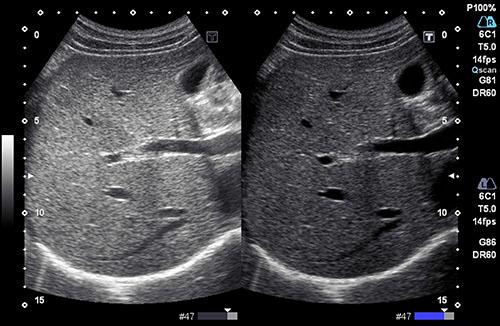 liver |
front 18 How to improve acoustic speckle? | back 18 THI |
front 19 What are the problems associated with acoustic speckle? | back 19 if too bad you will not be able to see (fat encompassing) |
front 20 Reverberation | back 20 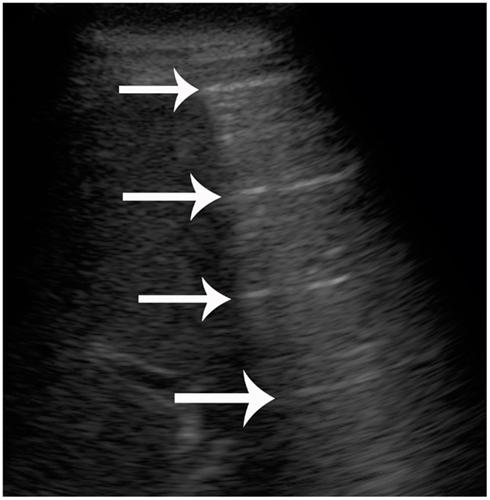 bouncy ball |
front 21 Ring down artifact | back 21 ring down occurs with gas filled loops of bowel |
front 22 Comet trails | back 22 squeezed out reverberation |
front 23 mirror image | back 23 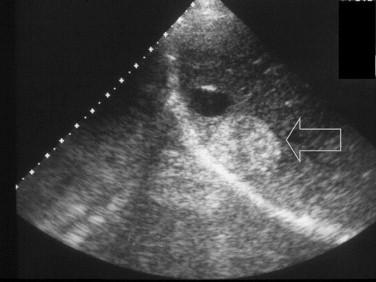 and improper location caused by a change in propagation speed |
front 24 What frequently causes mirror image? | back 24 diaphragm |
front 25 Spectral mirroring | back 25 when spectral doppler appears in both sides of the baseline |
front 26 what is a common cause of spectral doppler? | back 26 receiver gain too high |
front 27 How do you fix spectral mirroring? | back 27 change angle |
front 28 What type of transducer produces side lobes? | back 28 single element |
front 29 What type of transducer produces grating lobes? | back 29 array transducers |
front 30 What causes lobes? | back 30 weak beams that might otherwise be ignored hit a strong reflector. the reflected echoes become misplaced. |
front 31 How do you get rid of lobes? | back 31 subdicing the element using dynamic apodization |
front 32 apodization | back 32 weakening of the outside elements listening is decreased on the side |
front 33 How do speed errors occur? | back 33 system works on the assumption that sound will make a round trip through soft tissue in 13 μs/cm |
front 34 Where is the object placed if the speed is faster than 13 μs/cm? | back 34 closer |
front 35 Where is the object placed if the speed is slower than 13 μs/cm? | back 35 farther |
front 36 Split off artifact | back 36 object in front of another object causes the sound to travel faster or slower only on a portion of the second object. Part of the object usually the diaphragm is placed incorrectly and the object appears cut |
front 37 step off artifact | back 37 aka split off artifact |
front 38 cut artifact | back 38 aka split off artifact |
front 39 What causes Range ambiguity? | back 39 caused by deep echoes from a previous pulse |
front 40 what is range ambiguity? | back 40 object is placed closer and near the scan plane |
front 41 How can you correct range ambiguity? | back 41 Change frequency change depth change PRF most systems will adjust PRF |
front 42 What is shadowing | back 42 shadows distal to strong attenuator |
front 43 What causes shadowing? | back 43 strong reflector bouncing all sound back imediately strong absorber - no echoes left to return |
front 44 What causes edge shadowing? | back 44 reflections bouncing away when hitting a curved object - none return |
front 45 Dirty shadowing | back 45 usually occurs with bowels shadowing when internal echoes are present |
front 46 What is enhancement | back 46 hyperechoic areas distal to a a weak attenuator cysts |
front 47 What causes enhancement | back 47 an unexpected increase in amplitude |
front 48 focal enhancement | back 48 increased enhancement at the focus |
front 49 What can you do to correct focal enhancement? | back 49 spacial compounding |
front 50 what is thru transmission? | back 50 aka enhancement |
front 51 Aliasing | back 51 peaks cut off and place on bottom speeding ticket blood travels faster than the nyquist limit |
front 52 What can cause aliasing? | back 52 insufficient spatial sampling insufficient temporal sampling |
front 53 What can correct aliasing? | back 53 raise PRF - chance of range ambiguity increase doppler shift shift baseline - cosmetic switch to continuous wave |
front 54 What is the nyquist limit? | back 54 1/2 PRF |
front 55 PRF | back 55 pulses per second |
front 56 Artifact cause axial resolution | back 56 pulse length |
front 57 Artifact cause lateral resolution | back 57 pulse width |
front 58 Artifact cause section thickness | back 58 pulse width |
front 59 Artifact cause speckle | back 59 interference |
front 60 Artifact cause reverberation | back 60 multiple reflections |
front 61 Artifact cause refraction | back 61 refraction |
front 62 Artifact cause multipath | back 62 multiple reflections |
front 63 Artifact cause mirror image | back 63 multiple reflections |
front 64 Artifact cause side lobes | back 64 side lobes |
front 65 Artifact cause grating lobes | back 65 grating lobes |
front 66 Artifact cause comet trail | back 66 reverberation |
front 67 Artifact cause ring down | back 67 resonance |
front 68 Artifact cause speed error | back 68 speed error |
front 69 Artifact cause range ambiguity | back 69 high PRF |
front 70 Artifact cause shadowing | back 70 high attenuation |
front 71 Artifact cause enhancement | back 71 low attenuation |
front 72 Artifact cause edge shadowing | back 72 refraction |
front 73 Artifact cause focal enhancement | back 73 focusing |
front 74 Artifact cause aliasing | back 74 low PRF |
front 75 Artifact cause spectral mirroring | back 75 high doppler gain |
front 76 Which testing is the most challenging? | back 76 Doppler |
front 77 What part of the system is most likely to break down? | back 77 transducer electric shock |
front 78 Why do we perform performance testing? | back 78 to prevent degradation of image |
front 79 What do acoustic output testers evaluate? | back 79 beam former and transducer acting together as a source of ultrasound |
front 80 what do flow testers evaluate? | back 80 Doppler |
front 81 What do detail testers evaluate? | back 81 lateral and axial resolution |
front 82 What so output testers evaluate? | back 82 sound output |
front 83 What is the goal of system testers? | back 83 detect gradual changes in system performance |
front 84 Who does the responsibility of quality assurance rest? | back 84 sonographer |
front 85 How often should equipment be tested? | back 85 one a month |
front 86 Perfecting these methods is _____ but must be done & must be ______. | back 86 difficult repeatable |
front 87 What do AIUM test objects test for? | back 87 slice thickness beam width detail resolution\depth accuaracy measurement accuracy dead zone |
front 88 What is the main problem with AIUM test objects? | back 88 no attenuation properties |
front 89 What is the AIUM test object usually filled with? | back 89 water but sometimes no water |
front 90 What is the main advantage of the AIUM test object | back 90 price |
front 91 What does the tissue/cyst phantum test for? | back 91 detail resolution dynamic range time gain compensation contrast resolution |
front 92 What does the cyst phantom contain | back 92 columns of simulated cysts |
front 93 How do you fix lateral smearing? | back 93 decrease depth (increases frame rate - improves temporal resolution) |
front 94 Describe the constructions of the tissue phantum | back 94 rubber face & sides plexiglass base cosists of cystic, nylon other materials |
front 95 What is the test phantom filled with? | back 95 gel - 1.54 rubber - 1.45 |
front 96 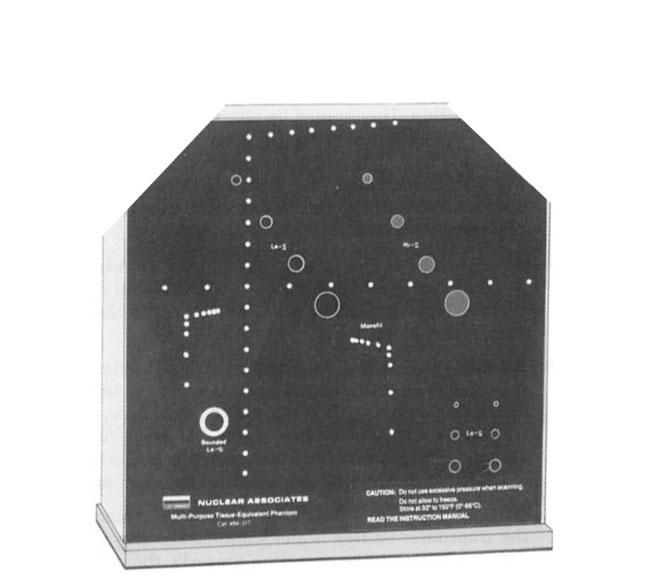 How would you test the dead zone? | back 96 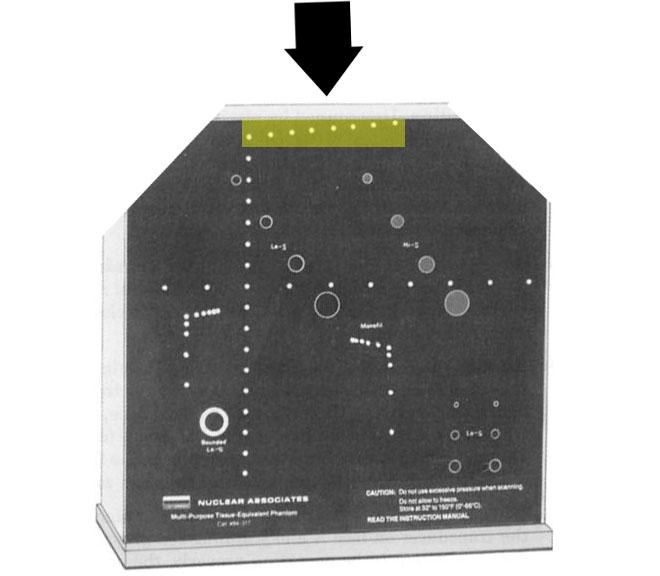 |
front 97 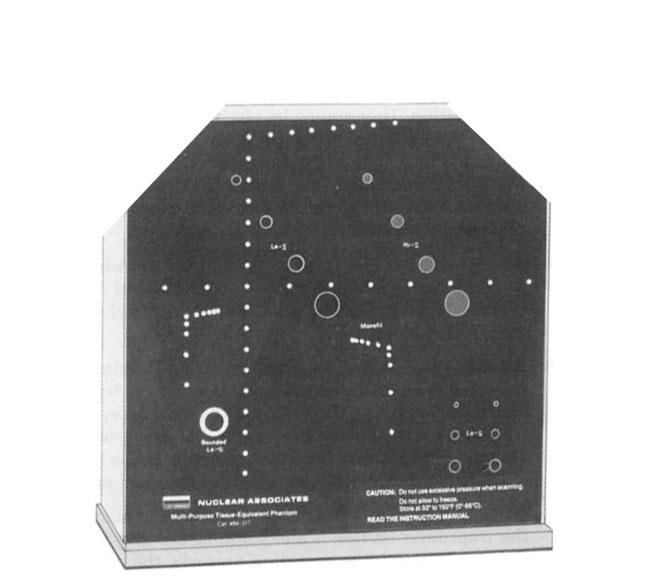 How do you evaluate cysts | back 97 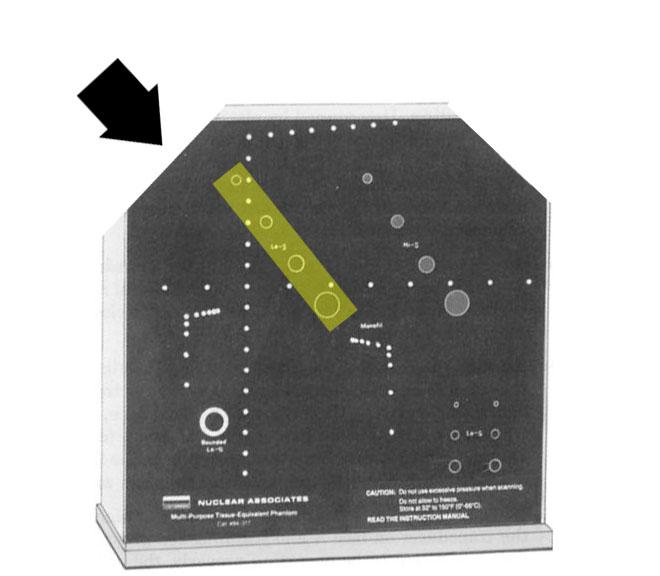 |
front 98 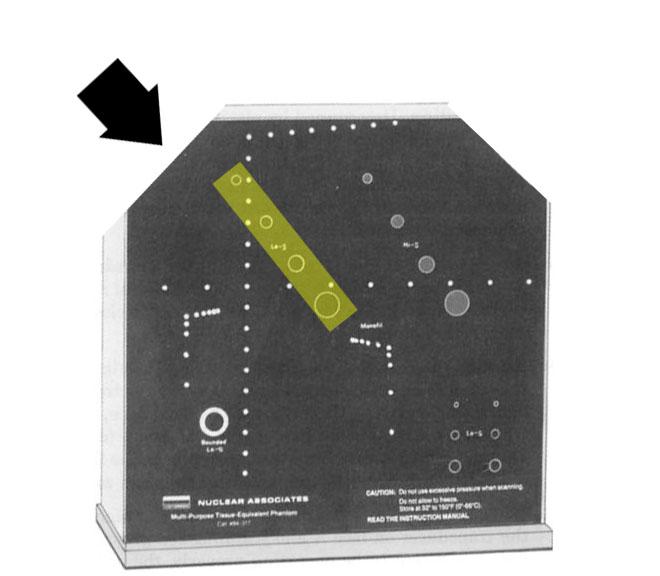 What does the cyst evaluation show? | back 98 size and depth variation |
front 99 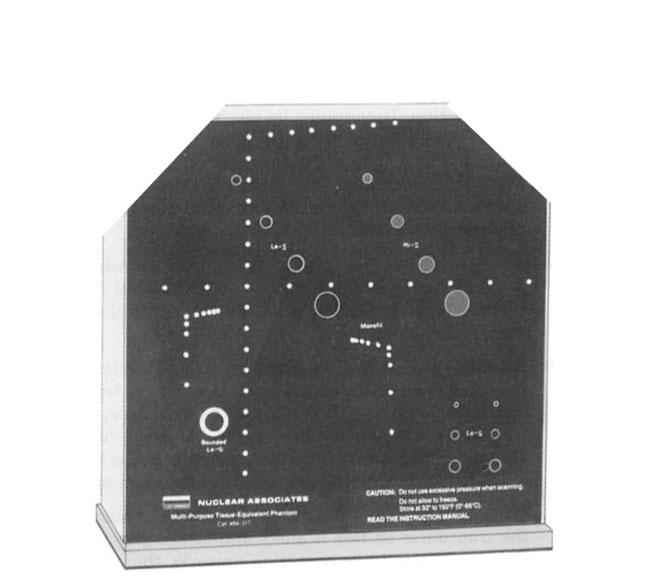 How would you evaluate axial resolution? | back 99 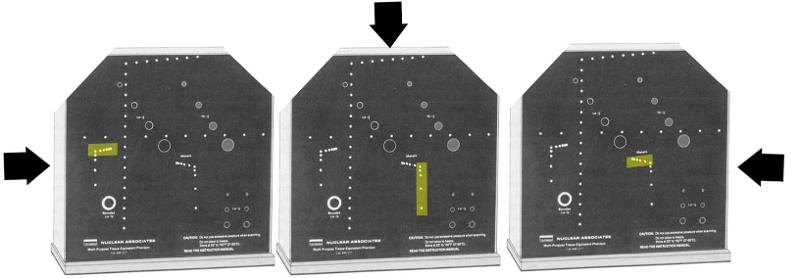 |
front 100 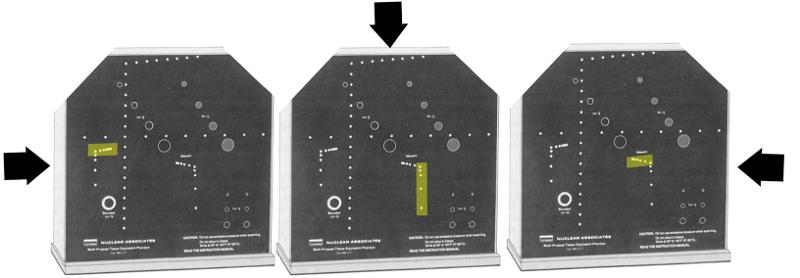 What does this test for? | back 100 axial resolution smallest distance two pins can be seen as two separate pins |
front 101 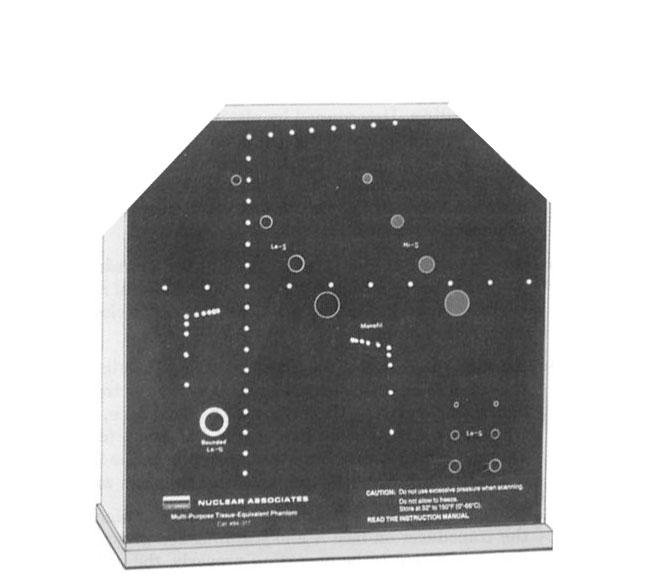 How would you evaluate vertical registration? | back 101 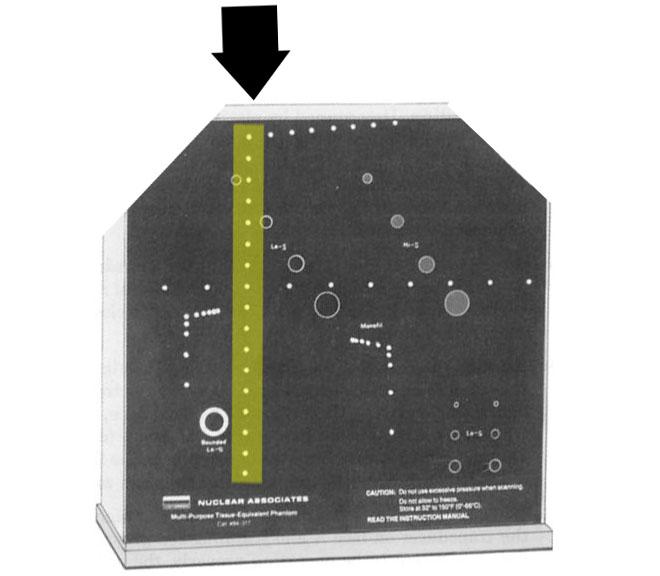 |
front 102 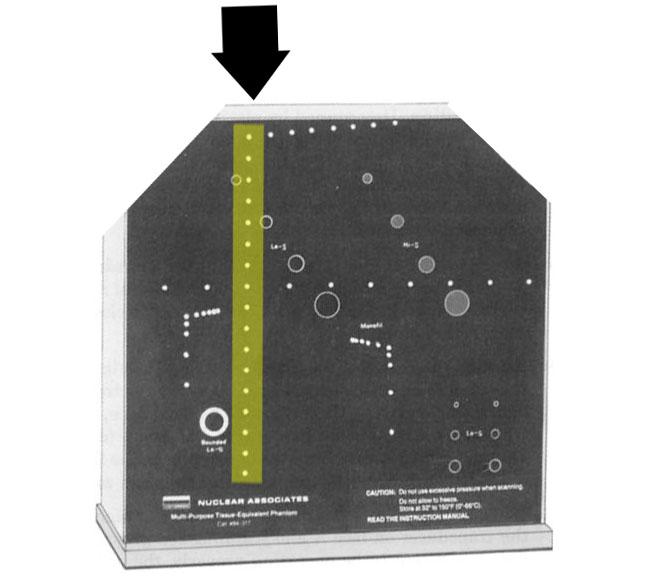 What does this test for? | back 102 vertical registration / range accuracy ability to display echoes at the proper depth or top line |
front 103  How would you evaluate Horizontal registration? | back 103 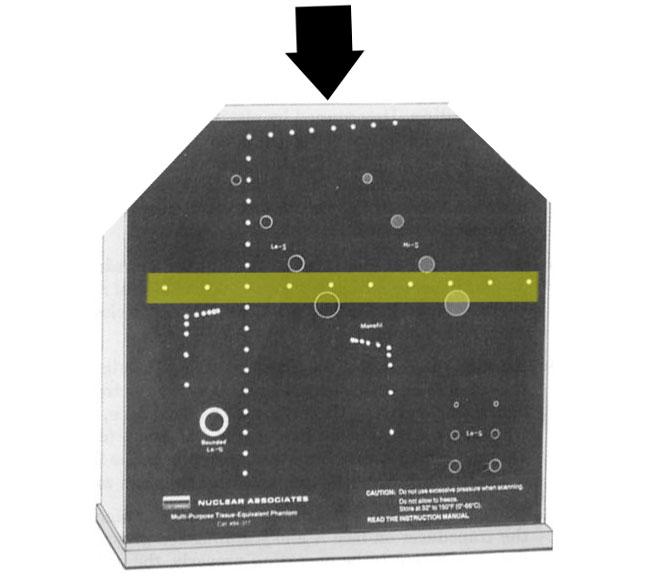 |
front 104 What does this test for? | back 104 Horizontal registration the ability to position echoes in the their correct position along a line that is perpendicular to the ultrasound beam |
front 105 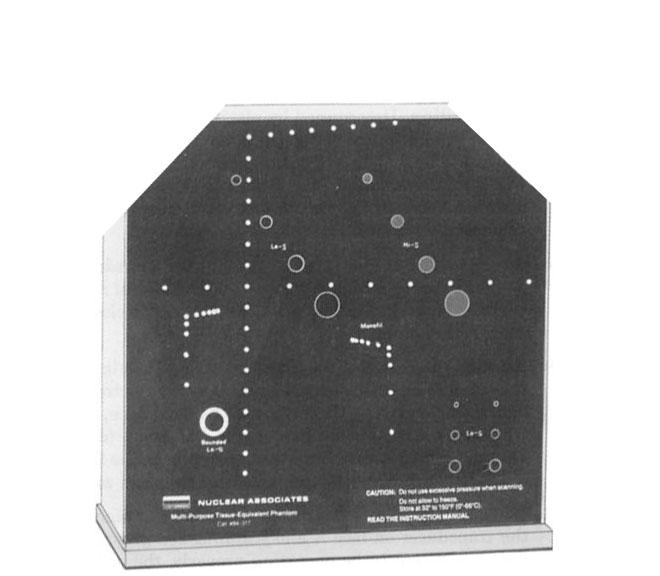 How would you evaluate lateral resolution? | back 105 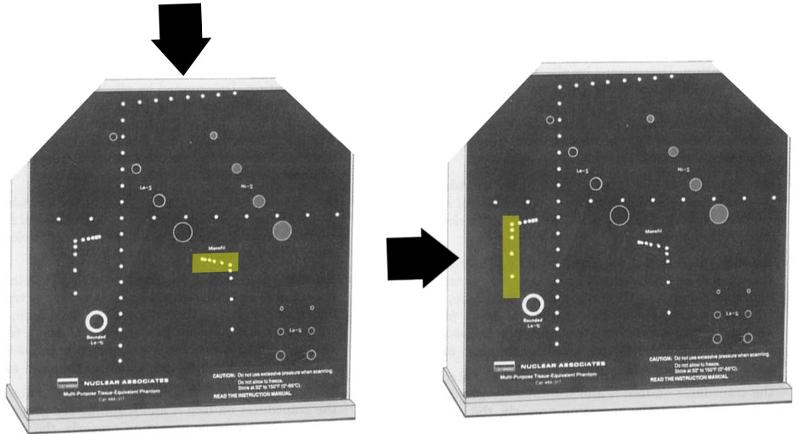 |
front 106 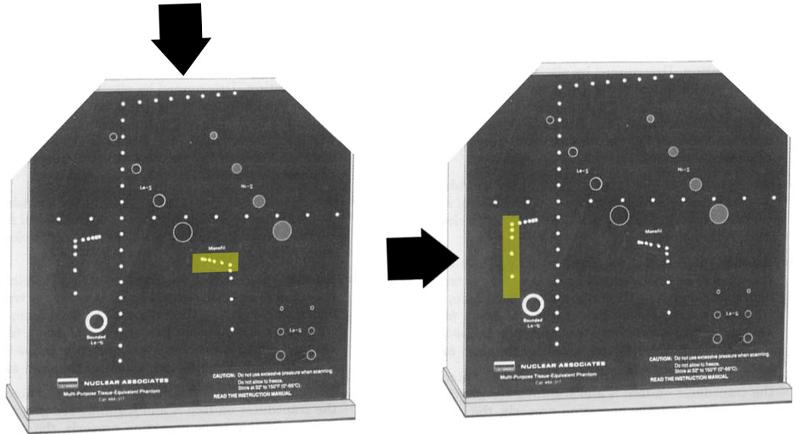 What does this test for? | back 106 lateral resolution minimum distance two pins can be seen as two separate pins at a specific depth |
front 107 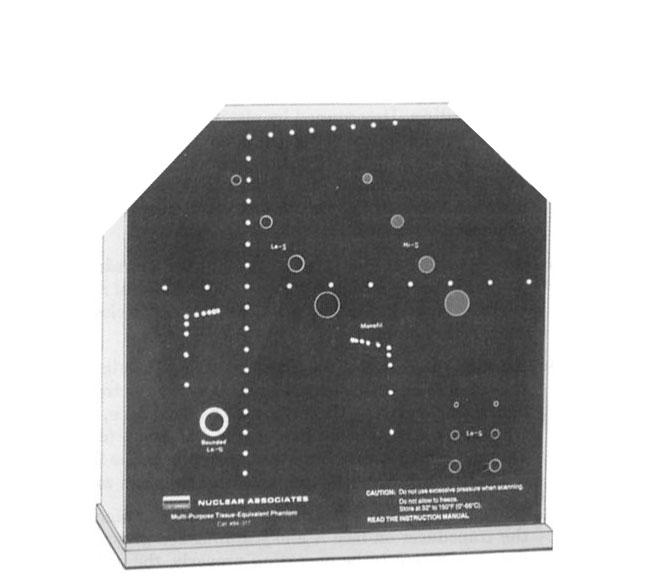 How would you evaluate grey scale? | back 107 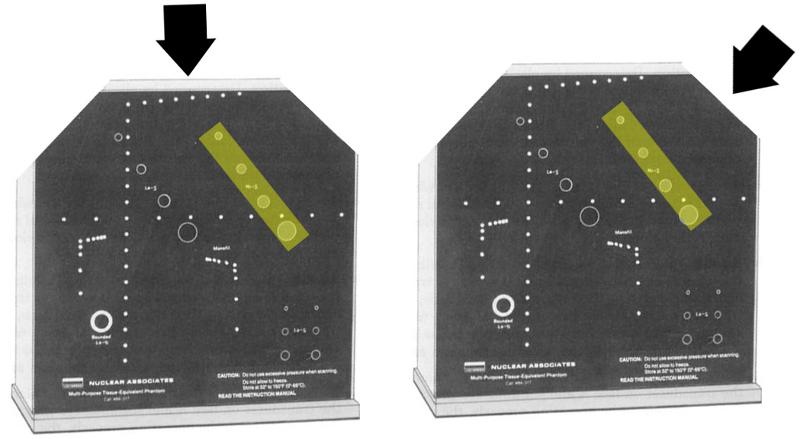 |
front 108 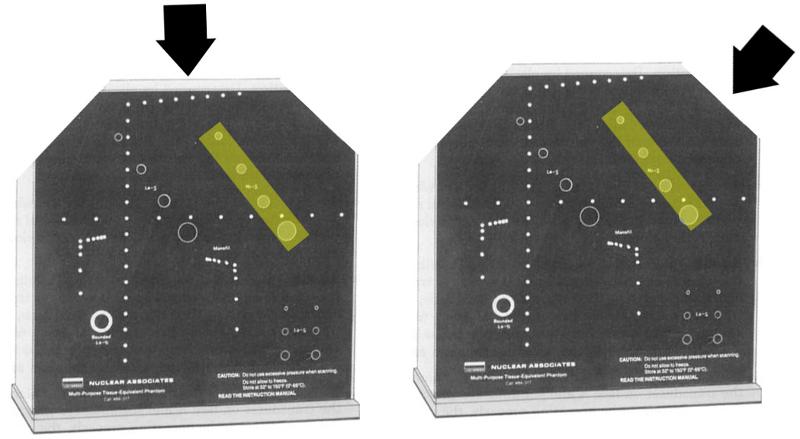 What does this test for? | back 108 grayscale / contrast resolution the ability to discriminate between 2 different objects that have different shades of grey |
front 109 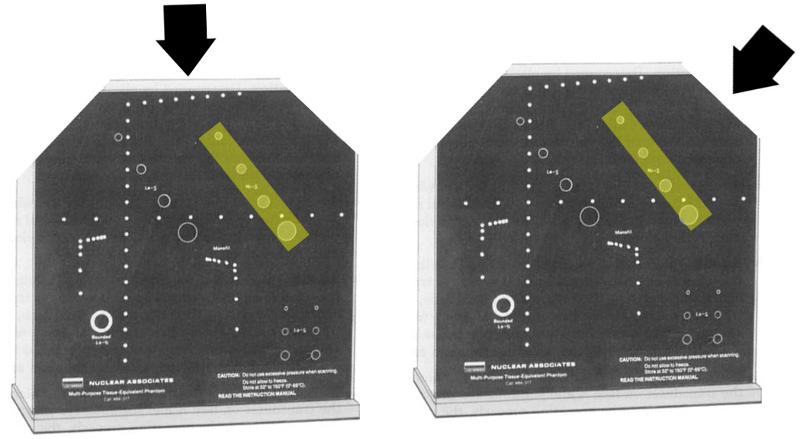 What is the difference between these two test for contrast resolution? | back 109 the first one has size variation the second one has depth variation |
front 110 Minimum sensitivity | back 110 start by making TGC flat then increase gain from minimum value the point the echo appears on screen is minimum sensitivity |
front 111 Normal sensitivity | back 111 is the point in which all the pins on an AIUM test object are displayed |
front 112 Sensitivity | back 112 is the range that echoes are barely visible to fully sensitivity |
front 113 lateral resolution | back 113 the minimum distance that two rods are displayed as two separate images at a specific depth |
front 114 Focal zone | back 114 the depth at which the intensity is the highest and beam is the narrowest this may be found using beam profiler or hydrophone |
front 115 Dynamic range / greyscale | back 115 change in gain should result in a change in greyscale |
front 116 vertical registration / range accuracy | back 116 the machines ability to display echoes at the proper depth |
front 117 depth calibration | back 117 the accuracy of B mode, m mode and A mode on displaying the depth of reflectors |
front 118 horisontal calibration | back 118 the machines ability to position echoes in the correct postiion perpendicular to the U/S beam |
front 119 longitudinal resolution | back 119 smallest distance at which two pins are displayed as two separate echoes in their position parallel to the beam |
front 120 What do the Doppler performance tools evaluate? | back 120 the effective position of the Doppler beam (penetration) accuracy of measured flow accuracy volume and flow speed |
front 121 What do we use for Doppler testing? | back 121 Blood tissue phantom Doppler testing object |
front 122 What is a Blood tissue phantom | back 122 Doppler testing the mimicks blood
|
front 123 What is a Doppler testing object? | back 123 Doppler test object uses controlled movement of strings
|
front 124 What are the disadvantages of the Doppler string phantom? | back 124
|
front 125 What does a Blood tissue phantom contain? | back 125 an image face medium a flow conduit pump blood mimick reservoir |
front 126 How does a Blood tissue phantom work? | back 126 complex tube connects to a pump pumps an echogenic fluid through out a known velocity simulates a stenosis. |
front 127 What is a microprobe? | back 127 small transducer on a hollow needle |
front 128 What is a hydrophone? | back 128 large piezoelectric membrane with electrodes on both sides |
front 129 What are microprobe and hydrophone used for? | back 129 Measure intensity produce a waveform on an oscilloscope |
front 130 What do microprobe and hydrophone use as a piezoelectric material? | back 130 PVDF |
front 131 How do microprobe and hydrophone work? | back 131 receive sound from all directions measure pressure at a given point within the beam in response to the varying pressure the hydrophone produces a varying voltage |
front 132 What is the voltage produced by a hydrophone displayed on? | back 132 oscilloscope |
front 133 What does an oscilloscope display? | back 133 bandwidth |
front 134 What do hydrophones measure? | back 134 frequency PRF duty factor pressure amplitude wavelength SPL intensity |
front 135 Which type of U/S produces the greatest acoustic output? | back 135 Pulsed Spectral Doppler Color Doppler M mode B mode |
front 136 Intensity and output indexes have already been copulated using a ______. | back 136 hydrophone |
front 137 What is the #1 assumption of risk? | back 137 U/S is energy and any energy applied to human cells can cause change |
front 138 What is the rule of U/S? | back 138 risk benefit ratio any possible benefit must outweigh possible risks
|
front 139 How do we increase benefit? | back 139 Better equipment
Better operator
|
front 140 How do we decrease risk? | back 140 decrease output/exposure
decrease bioeffects
|
front 141 Do you need a Doctors orders for an ultrasound exam? | back 141 Yes medical device regulates by the FDA |
front 142 What are the two types of mechanical bioeffects? | back 142 cavitation radiation |
front 143 What is radiation? | back 143 the amount of force that a beam exerts on an absorber or reflector |
front 144 What are the two types of bioeffects? | back 144 heating - attenuation of U/S is primary by heat cavitation - motion of microbubbles |
front 145 What is heating primarily due to? | back 145 absorption |
front 146 Why does absorption cause heating? | back 146 absorption involves conversion of U/S to heat |
front 147 U/S produce a temp. rise as it propagates through tissue | back 147 no data |
front 148 What happens to heat when intensity goes up? | back 148 rises |
front 149 What happens to heat when frequency goes up? | back 149 rises |
front 150 What can Rayleighs scattering cause? | back 150 Thermal injury |
front 151 Where are temperature elevations more likely to occur? | back 151 tissue-bone interface |
front 152 What area is of great concern to thermal injury? | back 152 soft tissue adjacent to bone in a fetus |
front 153 What is SPTA associated with? | back 153 tissue heating |
front 154 What exam can be used without fear? | back 154 any exam that causes elevation in temperature of less than 2 degrees Celcius |
front 155 What exam may cause harm in a fetus? | back 155 an exam that causes an elevation of temperature of greater than 41 degrees Celcius |
front 156 What does Rayleigh scattering cause? | back 156 RBC to scatter |
front 157 What is Rayleigh scattering? | back 157 when the wavelength of the incident sound beam is smaller than the size of the RBC |
front 158 Which causes higher Temperature elevation Pulsed wave or Continuous wave? | back 158 CW causes higher temperature elevation |
front 159 Which causes higher Temperature elevation Focused or unfocused? | back 159 unfocused causes higher temperature elevation * focused has a narrow beam and heat is easily dispersed |
front 160 What is cavitation? | back 160 the production and behavior of bubbles in a liquid medium |
front 161 Where would a sound wave may cause cavitation? | back 161 Nucleation sites tissue with gas bubbles |
front 162 What are the two types of cavitation? | back 162 stable cavitation transient cavitation |
front 163 What is stable cavitation? | back 163 expand and contract bubbles that oscillate in diameter with the passing pressure of a sound wave bubbles don't burst causes shear stress - cutting force |
front 164 What does shear force cause? | back 164 microstreaming |
front 165 What is microstreaming? | back 165 rapid rotational flow that occurs in intact blood vessels |
front 166 What is shear stress? | back 166 cutting force |
front 167 What is transient cavitation? | back 167 bubbles expand and collapse violently bubbles burst |
front 168 What is another name for transient cavitation? | back 168 Collapse / inertial cavitation |
front 169 What does transient cavitation cause? | back 169 destructive effects shockwaves light emissions high temperature |
front 170 What is Thermal index? | back 170 heat production index - deals with bioeffects caused by heating |
front 171 If a machine can exceed thermal or mechanical indexes what must be? | back 171 acoustic output displayed |
front 172 What is Mechanical index | back 172 Motion production index - deals with bioeffects caused by cavitation |
front 173 What is the thermal index measured in? | back 173 degrees celcius |
front 174 Which display is preferred SPTA or Thermal index? | back 174 Thermal index - more accurate |
front 175 What should SPTA be below? | back 175 720 mw/cm2 |
front 176 TIS | back 176 Thermal index soft tissue |
front 177 TIB | back 177 Thermal index bone |
front 178 TIC | back 178 Thermal index cranial |
front 179 TI of 2 or less = | back 179 expected heating of 2 degrees or less |
front 180 Mechanical index formula | back 180 MI = derated peak rarefractional pressure / sqrt (U/S center frequency |
front 181 What is threshold for MI? | back 181 .3 or less |
front 182 What is normal body temperature? | back 182 37 degrees C |
front 183 What is the max body temp rise? | back 183 39 degrees C |
front 184 C to F | back 184 37°C x 9/5 + 32 = 98.6°F |
front 185 F to C | back 185 (98.6°F - 32) x 1.8 = 37°C (98.6°F - 32) x 5/9 = 37°C |